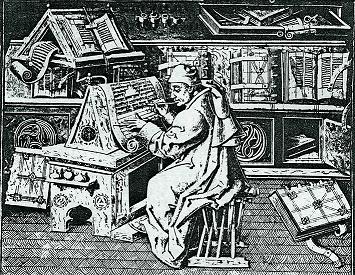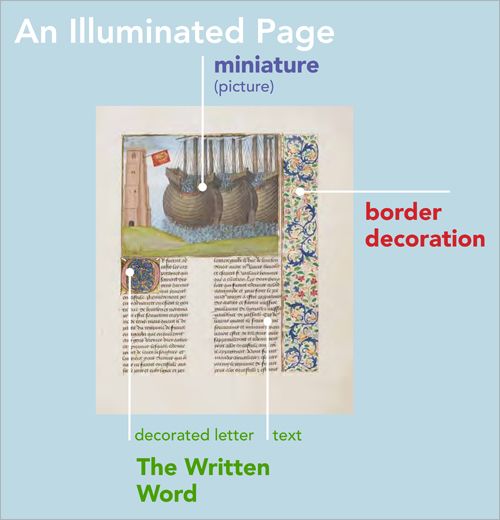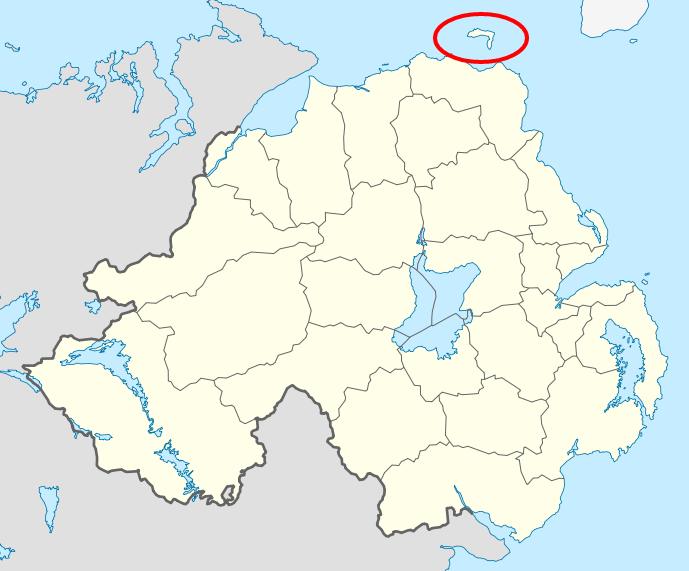Context
Welcome to the Middle Ages!

Modern Manual to Bookmaking Step 1: Pick a tree and chop it down. (via)
Welcome to the Middle Ages, 8th graders! Mrs. Brown has asked me to help you understand more about how manuscripts were made before the printing press was invented. It may seem foreign to you, as you look around the room and see hundreds of bound books on the shelves, but books in the Middle Ages were created from scratch–including the paper (parchment) and inks themselves. Imagine if you had to do everything, from cutting down trees to make your own paper to catching specific bugs to make red ink, just to do your homework!
Over the next few class periods, your groups are going to take on the roles of monks and nuns who will be traveling to open a new monastery or nunnery on a remote island near Northern Ireland. Your group of nuns/monks specifically has been tasked with planning and setting up the scriptorium where manuscripts will be created. During the planning stages, you will be developing a how-to guide that will help future nuns and monks set up a scriptorium as well. I’ll be walking you through the information you’ll need to create the tutorial and lead you to additional resources to find out more yourself, but your group will need to come up with a plan about how you want the step-by-step guide to look. Be careful to keep in mind all of the things that you need in the scriptorium itself as well as the things and nearby planned spaces (gardens, animal pens) that the scribes will need as they work. (This means your guide should include steps about other things and spaces that need to be planned and kept as well.)
Think of it as your chance to create your very own manuscript!
After each group has created the build-your-own-scriptorium manual, something interesting is going to happen: you will have to give your guidebook to another group, and they will have to use it to create a scriptorium in some way. You also need to include a close-up view of a scribe’s desk, including the objects that would typically be found on it. Your group will work together to decide what method works best for all of you. Some options include a diorama, a digitally created image of the space and items in it, drawings, architectural-type layouts, and so on. Be creative!
Here’s the catch: because you’re using the other person’s manual, you must take care to “build” it in a way that fits with their descriptions. Your group will also write a review of how the “building” process went as a way to assess the guidelines you were given.
Some of the things to keep in mind while you’re following the manual include the following:
- Do you think anything was left out?
- What would you have added or what do you think should have been mentioned?
- Was there anything that surprised you?
- Did you find things that you might have left out of your own manual that you now think you should have included?
What is a scriptorium anyway?

Scribe in a medieval scriptorium. (via)
Why don’t we back up a bit and take a look at some of the terminology we’re going to run into that you may be unfamiliar with? In Latin, scriptorium literally means “a place for writing.” The early scriptorium was usually a niche or space (such as separate carrels) set aside for the scribe to do his work. Over time, the scriptorium became a room attached to a monastery that had space for more than one scribe, or person who was meticulously trained to write the text for a manuscript, and a place apart for this particular purpose. Scribes were generally monks who were trained to copy the texts to create new manuscripts, although later secular, non-religious scribes were trained (usually supervised by a monk). At this time, writing/copying manuscripts, particularly sacred texts, was considered holy work and was held in high regard as a noble task.

Example of an illuminated manuscript page (via)
Manuscripts are handwritten books. When you hear this term, it most often will mean a handwritten text from the Middle Ages. Imagine the time it took to create a text by hand! Manuscripts were most often owned by very wealthy people. Many times, someone else trained in art and painting would create illuminations in the work, which means that they also included drawings, paintings, pictures, and intials (the fancy, decorated letters you often see at the beginning of a new chapter or section of a manuscript). These were often very detailed and carefully created.
The example to the right shows an example of what a manuscript page might look like after the scribe has finished writing the text and the illuminator has finished his embellishments of that particular page. Your job is going to be to help create the space where these people can all work together in their painstaking work to create a completed manuscript.
Let’s watch a quick video to tie these things together and to give you a quick look ahead at a few of the things we’re going to look at (preparation for parchment, inks, and bindings).
Although this video has Spanish descriptive text, I have translated the information and included it in the handout for you. (If you were absent the day the translation handout was given out, click this link to download it before watching the video below: Scriptorium Video Translation Handout.)
Who am I and where am I going?
You are a small group of Irish nuns or monks, setting out to Rathlin Island. As members of the Catholic church, nuns and monks often lived apart from general society for various reasons and within the guidelines of their specific order or group. They live in monasteries (for monks) and convents (for nuns), the setup for which could be different depending upon the order that the nun or monk chose to join. Catholicism was still expanding during this time period, and Irish monks and nuns felt the need to spread Christianity to as many of their people as possible. A professor I had said it quite succinctly: “And so they would get into a little boat and they’d push out to sea and go wherever the current took them” (Main, “The Medieval World” lecture).
Your group, however, has a destination in mind. Instead of letting the sea inform your travels, you’ve decided that you will be setting up a new site on Rathlin Island. Let’s find out where we’re going (video created by instructor using Google Earth):

Rathlin Island is circled in red. (original image)
This means we’re going to end up on an island just north of Northern Ireland, as you can see on the static map to the right.
Rathlin Island has had a long, storied history, but why don’t we start in 580 A.D. when the first church was established by Saint Comgall. The second was established in 630 A.D. by Sigenius, but in 795 A.D. “Vikings arrived on the island and raided the monasteries for their gold. However, most of the invaders eventually converted to Christianity.” This was the first recorded Viking attack on Irish soil.
The island is about six to seven miles long and one mile wide, and it has a distinctive L-shape. Because of its close location to Scotland, it has been the starting point for disputes about what country owns the island, but eventually it was settled as a part of Ireland in 1617 and is now the northernmost point of Northern Ireland. Today is is home to beautiful vistas, interesting birds and wildlife, and an unusual number of shipwrecks off its coasts.
I want to know more
This section has links for further study about the items mentioned above. Check them out before starting your assignment to get more in-depth knowledge that will help you better understand the guide you are about to create. (You will find a similar section at the bottom of each page, so be sure to do more research by checking out some of the additional information given.)
Scriptorium (plural = scriptoria):
- “The Medieval Scriptorium” from The J. Paul Getty Museum
- “Secrets of Scriptoria” from History Today
- “What is a Scriptorium?” from wiseGEEK
- “Where are the Scriptoria?” from medievalfragments
Scribes and Manuscripts:
- Late Medieval English Scribes (catalog of scribe’s handwriting, which can help identify which scribes wrote which manuscripts — and how many different scribes might have worked on just one manuscript!)
- “The Medieval Scribe” from the Marche of Alderford, a branch off the Society of Creative Anacrhonism, Inc.
- “What is a Manuscript” from Heritage Hawks
- Manuscripts from J. Paul Getty Museum via Khan Academy
- “Scribal Arts,” a page that includes snippets of information from around the web about scribes, manuscript making, and tools
Rathlin Island:
- “Island History” from the official Rathlin Island page
- “Rathlin Island” from Discover Northern Ireland
- “The Medieval History of Rathlin Island (400-1400)” from Culture Northern Ireland
- “Rathlin Island” from Ballycastle
- “Antrim” from Discovering Ireland
- “The Viking Age in Ireland” from Viking Network Ireland
Ready to go?
Let’s go! There are links on the side and at the top of the page to help you navigate through this lesson, so use whichever feels most comfortable for you as your group listens to the lessons.